A Structure Identification Method for Urban Agglomeration Based on Nighttime Light Data and Railway Data
Abstract
1. Introduction
2. Data and Study Area
2.1. Study Area
2.2. Data
2.3. Reference Data
2.3.1. Urban Agglomerations
2.3.2. Core Cities
3. Method
3.1. Preprocessing
3.2. Composite Urban Network Construction
3.2.1. Nighttime Light Urban Network
3.2.2. Railway Urban Network
3.2.3. Composite Urban Network Construction
3.3. Spatial Structure Method to Identify Urban Agglomeration Using Composite Urban Network
4. Results and Analysis
4.1. Composite Urban Network
4.2. Spatial Structure of Urban Agglomeration
4.2.1. Urban Agglomeration
4.2.2. Core City Identification
5. Discussion
6. Conclusions
Author Contributions
Funding
Data Availability Statement
Conflicts of Interest
References
- Fang, C.; Yu, D. Urban agglomeration: An evolving concept of an emerging phenomenon. Landsc. Urban Plan. 2017, 162, 126–136. [Google Scholar] [CrossRef]
- Wu, J.; Weber, B.A.; Partridge, M.D. Rural-Urban Interdependence: A Framework Integrating Regional, Urban, and Environmental Economic Insights; Wiley: Hoboken, NJ, USA, 2017; pp. 464–480. [Google Scholar]
- Fang, C.; Wang, Z.; Ma, H. The theoretical cognition of the development law of China’s urban agglomeration and academic contribution. Acta Geogr. Sin 2018, 73, 651–665. [Google Scholar]
- Zhu, X.; Wang, Q.; Zhang, P.; Yu, Y.; Xie, L. Optimizing the spatial structure of urban agglomeration: Based on social network analysis. Qual. Quant. 2021, 55, 683–705. [Google Scholar] [CrossRef]
- Liu, X.; Huang, J.; Lai, J.; Zhang, J.; Senousi, A.M.; Zhao, P. Analysis of urban agglomeration structure through spatial network and mobile phone data. Trans. GIS 2021, 25, 1949–1969. [Google Scholar] [CrossRef]
- Zhang, Y.; Yang, D.; Zhang, X.; Dong, W.; Zhang, X. Regional structure and spatial morphology characteristics of oasis urban agglomeration in arid area—A case of urban agglomeration in northern slope of Tianshan Mountains, Northwest China. Chin. Geogr. Sci. 2009, 19, 341–348. [Google Scholar] [CrossRef]
- Yu, B.; Shu, S.; Liu, H.; Song, W.; Wu, J.; Wang, L.; Chen, Z. Object-based spatial cluster analysis of urban landscape pattern using nighttime light satellite images: A case study of China. Int. J. Geogr. Inf. Sci. 2014, 28, 2328–2355. [Google Scholar] [CrossRef]
- Skadins, T.; Krumins, J.; Berzins, M. Delineation of the boundary of an urban agglomeration: Evidence from Riga, Latvia. Probl. Rozw. Miast 2019, 62, 39–46. [Google Scholar] [CrossRef]
- Sudra, P. Spatial dispersion and the concentration of buildings in an urban agglomeration–a typology proposal for the Warsaw Metropolitan Area. Environ. Socio-Econ. Stud. 2020, 8, 81–96. [Google Scholar] [CrossRef]
- Tan, X.; Huang, B. Identifying Urban Agglomerations in China Based on Density–Density Correlation Functions. In Annals of the American Association of Geographers; Taylor & Francis: Abingdon, UK, 2022; pp. 1–19. [Google Scholar]
- He, X.; Cao, Y.; Zhou, C. Evaluation of polycentric spatial structure in the urban agglomeration of the pearl river delta (PRD) based on multi-source big data fusion. Remote Sens. 2021, 13, 3639. [Google Scholar] [CrossRef]
- Huang, Y.; Liao, R. Polycentric or monocentric, which kind of spatial structure is better for promoting the green economy? Evidence from Chinese urban agglomerations. Environ. Sci. Pollut. Res. 2021, 28, 57706–57722. [Google Scholar] [CrossRef]
- Ma, H.; Xu, X. Knowledge Polycentricity of China’s Urban Agglomerations. J. Urban Plan. Dev. 2022, 148, 04022014. [Google Scholar] [CrossRef]
- Su, X.; Zheng, C.; Yang, Y.; Yang, Y.; Zhao, W.; Yu, Y. Spatial Structure and Development Patterns of Urban Traffic Flow Network in Less Developed Areas: A Sustainable Development Perspective. Sustainability 2022, 14, 8095. [Google Scholar] [CrossRef]
- Zhang, P.; Zhao, Y.; Zhu, X.; Cai, Z.; Xu, J.; Shi, S. Spatial structure of urban agglomeration under the impact of high-speed railway construction: Based on the social network analysis. Sustain. Cities Soc. 2020, 62, 102404. [Google Scholar] [CrossRef]
- Fang, C.; Yu, X.; Zhang, X.; Fang, J.; Liu, H. Big data analysis on the spatial networks of urban agglomeration. Cities 2020, 102, 102735. [Google Scholar] [CrossRef]
- Peng, J.; Lin, H.; Chen, Y.; Blaschke, T.; Luo, L.; Xu, Z.; Hu, Y.n.; Zhao, M.; Wu, J. Spatiotemporal evolution of urban agglomerations in China during 2000–2012: A nighttime light approach. Landsc. Ecol. 2020, 35, 421–434. [Google Scholar] [CrossRef]
- Zheng, W.; Kuang, A.; Liu, Z.; Wang, X. Analysing the spatial structure of urban growth across the Yangtze River Middle reaches urban agglomeration in China using NPP-VIIRS night-time lights data. GeoJournal 2022, 87, 2753–2770. [Google Scholar] [CrossRef]
- Sun, X.; Wu, Y.; Feng, X. Structure Characteristics and Robustness Analysis of Multi-Layer Network of High Speed Railway and Ordinary Railway. J. Univ. Electron. Sci. Technol. China 2019, 2, 315–320. [Google Scholar]
- Bindu, P.; Thilagam, P.S.; Ahuja, D. Discovering suspicious behavior in multilayer social networks. Comput. Hum. Behav. 2017, 73, 568–582. [Google Scholar] [CrossRef]
- Millán, A.P.; Torres, J.J.; Bianconi, G. Complex network geometry and frustrated synchronization. Sci. Rep. 2018, 8, 1–10. [Google Scholar] [CrossRef]
- Hu, H.; Huang, X.; Li, P.; Zhao, P. Comparison of Network Structure Patterns of Urban Agglomerations in China from the Perspective of Space of Flows: Analysis based on Railway Schedule. J. Geo-Inf. Sci. 2022, 24, 1525–1540. [Google Scholar]
- Jian-bo, L.; Jing-hu, P. Spatial pattern of population flow among cities in China during the Spring Festival travel rush baed on “Tencent migration” data. Hum. Geogr. 2019, 34, 108–117. [Google Scholar]
- Wei, C.; Weidong, L.; Wenqian, K.; Nvying, W. The spatial structures and organization patterns of China’s city networks based on the highway passenger flows. Acta Geogr. Sin. 2017, 72, 224–241. [Google Scholar]
- Girvan, M.; Newman, M.E. Community structure in social and biological networks. Proc. Natl. Acad. Sci. USA 2002, 99, 7821–7826. [Google Scholar] [CrossRef] [PubMed]
- Zhang, Z.; Pu, P.; Han, D.; Tang, M. Self-adaptive Louvain algorithm: Fast and stable community detection algorithm based on the principle of small probability event. Phys. A Stat. Mech. Appl. 2018, 506, 975–986. [Google Scholar] [CrossRef]
- Clauset, A.; Newman, M.E.; Moore, C. Finding community structure in very large networks. Phys. Rev. E 2004, 70, 066111. [Google Scholar] [CrossRef]
- Raghavan, U.N.; Albert, R.; Kumara, S. Near linear time algorithm to detect community structures in large-scale networks. Phys. Rev. E 2007, 76, 036106. [Google Scholar] [CrossRef]
- Xueguang, M.; Yu, L. Spatial Structure and Connection of Cities in China Based on Air Passenger Transport Flow. Econ. Geogr. 2018, 38, 47–57. [Google Scholar]
- Lu, F.; Liu, K.; Duan, Y.; Cheng, S.; Du, F. Modeling the heterogeneous traffic correlations in urban road systems using traffic-enhanced community detection approach. Phys. A Stat. Mech. Appl. 2018, 501, 227–237. [Google Scholar] [CrossRef]
- Blondel, V.D.; Guillaume, J.-L.; Lambiotte, R.; Lefebvre, E. Fast unfolding of communities in large networks. J. Stat. Mech. Theory Exp. 2008, 2008, P10008. [Google Scholar] [CrossRef]
- Zhang, Q.; Yuan, T. Analysis of China’s Urban Network Structure from the Perspective of “Streaming”. In Proceedings of the 2018 26th International Conference on Geoinformatics, Kunming, China, 28–30 June 2018; pp. 1–7. [Google Scholar]
- Huanyong, H. Distribution of China’s population with statistical tables and density maps. Acta Geogr. Sin. 1935, 2, 33–74. [Google Scholar]
- Weng, Q. National Trends in Satellite-Observed Lighting: 1992–2012. In Global Urban Monitoring and Assessment through Earth Observation; CRC Press: Boca Raton, FL, USA, 2014; pp. 120–143. [Google Scholar]
- Ma, T.; Zhou, C.; Pei, T.; Haynie, S.; Fan, J. Quantitative estimation of urbanization dynamics using time series of DMSP/OLS nighttime light data: A comparative case study from China’s cities. Remote Sens. Environ. 2012, 124, 99–107. [Google Scholar] [CrossRef]
- GOYENA, R. A computer movie simulating urban growth in the detroit region. J. Chem. Inf. Model. 2019, 53, 1689–1699. [Google Scholar]
- Xiaoyue, Y. Study on 2-Hour Accessibility of High Speed Transportation Network in Yangtze River Delta City Group; Shanghai Normal University: Shanghai, China, 2021. [Google Scholar]
- Chao, L. Relationship between natural environment and highway engineering construction zoning. Public Commun. Sci. Technol. 2014, 6, 73+57. [Google Scholar]
- Xue-jun, W.; Yi-dong, Y.; Jing, F. Study on Expressway Operation Speed. J. Highw. Transp. Res. Dev. 2002, 19, 80–82. [Google Scholar]
- He, X.; Yuan, X.; Zhang, D.; Zhang, R.; Li, M.; Zhou, C. Delineation of urban agglomeration boundary based on multisource big data fusion—A case study of Guangdong–Hong Kong–Macao Greater Bay Area (GBA). Remote Sens. 2021, 13, 1801. [Google Scholar] [CrossRef]
- Cao, W.; Dong, L.; Wu, L.; Liu, Y. Quantifying urban areas with multi-source data based on percolation theory. Remote Sens. Environ. 2020, 241, 111730. [Google Scholar] [CrossRef]
- Gibson, J.; Olivia, S.; Boe-Gibson, G.; Li, C. Which night lights data should we use in economics, and where? J. Dev. Econ. 2021, 149, 102602. [Google Scholar] [CrossRef]
- Li, D.; Guo, W.; Chang, X.; Li, X. From earth observation to human observation: Geocomputation for social science. J. Geogr. Sci. 2020, 30, 233–250. [Google Scholar] [CrossRef]
- Shi, K.; Wu, Y.; Li, D.; Li, X. Population, GDP, and Carbon Emissions as Revealed by SNPP-VIIRS Nighttime Light Data in China with Different Scales. IEEE Geosci. Remote Sens. Lett. 2022, 19, 1–5. [Google Scholar] [CrossRef]
- Stokes, E.C.; Seto, K.C. Characterizing urban infrastructural transitions for the Sustainable Development Goals using multi-temporal land, population, and nighttime light data. Remote Sens. Environ. 2019, 234, 111430. [Google Scholar] [CrossRef]
- Hu, T.; Wang, T.; Yan, Q.; Chen, T.; Jin, S.; Hu, J. Modeling the spatiotemporal dynamics of global electric power consumption (1992–2019) by utilizing consistent nighttime light data from DMSP-OLS and NPP-VIIRS. Appl. Energy 2022, 322, 119473. [Google Scholar] [CrossRef]
- Chen, J.; Gao, M.; Cheng, S.; Liu, X.; Hou, W.; Song, M.; Li, D.; Fan, W. China’s city-level carbon emissions during 1992–2017 based on the inter-calibration of nighttime light data. Sci. Rep. 2021, 11, 1–13. [Google Scholar] [CrossRef] [PubMed]
- Chen, D.; Zhang, Y.; Yao, Y.; Hong, Y.; Guan, Q.; Tu, W. Exploring the spatial differentiation of urbanization on two sides of the Hu Huanyong Line—based on nighttime light data and cellular automata. Appl. Geogr. 2019, 112, 102081. [Google Scholar] [CrossRef]
- Yong, Z.; Li, K.; Xiong, J.; Cheng, W.; Wang, Z.; Sun, H.; Ye, C. Integrating DMSP-OLS and NPP-VIIRS Nighttime Light Data to Evaluate Poverty in Southwestern China. Remote Sens. 2022, 14, 600. [Google Scholar] [CrossRef]
- Expert, P.; Evans, T.S.; Blondel, V.D.; Lambiotte, R. Uncovering space-independent communities in spatial networks. Proc. Natl. Acad. Sci. USA 2011, 108, 7663–7668. [Google Scholar] [CrossRef]
- Wang, C.; Yu, B.; Chen, Z.; Liu, Y.; Song, W.; Li, X.; Yang, C.; Small, C.; Shu, S.; Wu, J. Evolution of urban spatial clusters in China: A graph-based method using nighttime light data. Ann. Am. Assoc. Geogr. 2022, 112, 56–77. [Google Scholar] [CrossRef]
- Guo, R.; Wu, T.; Liu, M.; Huang, M.; Stendardo, L.; Zhang, Y. The construction and optimization of ecological security pattern in the Harbin-Changchun urban agglomeration, China. Int. J. Environ. Res. Public Health 2019, 16, 1190. [Google Scholar] [CrossRef]
- Zhang, M.; Miao, W.; Yang, Y.; Peng, C.; Huang, Y. Spatial-Temporal Features of Wuhan Urban Agglomeration Regional Development Pattern—Based on DMSP/OLS Night Light Data. J. Build. Constr. Plan. Res. 2017, 5, 14. [Google Scholar] [CrossRef][Green Version]
- Zhang, Z.; Liu, Y. Spatial Expansion and Correlation of Urban Agglomeration in the Yellow River Basin Based on Multi-Source Nighttime Light Data. Sustainability 2022, 14, 9359. [Google Scholar] [CrossRef]
- Zhao, Y.; Zhang, G.; Zhao, H. Spatial network structures of urban agglomeration based on the improved Gravity Model: A case study in China’s two urban agglomerations. Complexity 2021, 2021, 6651444. [Google Scholar] [CrossRef]
- He, X.; Zhu, Y.; Chang, P.; Zhou, C. Using Tencent User Location Data to Modify Night-Time Light Data for Delineating Urban Agglomeration Boundaries. Front. Environ. Sci. 2022, 10, 860365. [Google Scholar] [CrossRef]
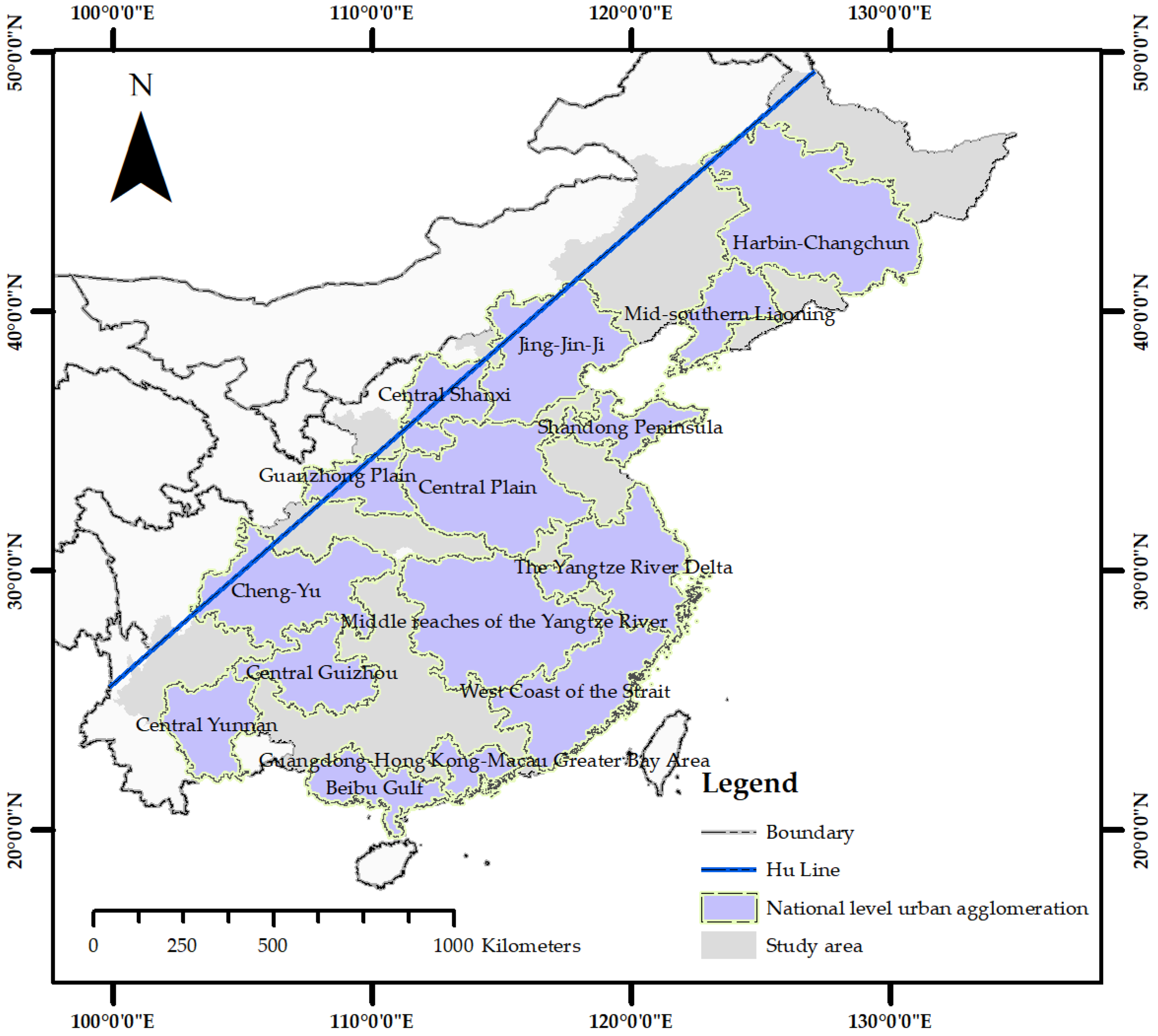
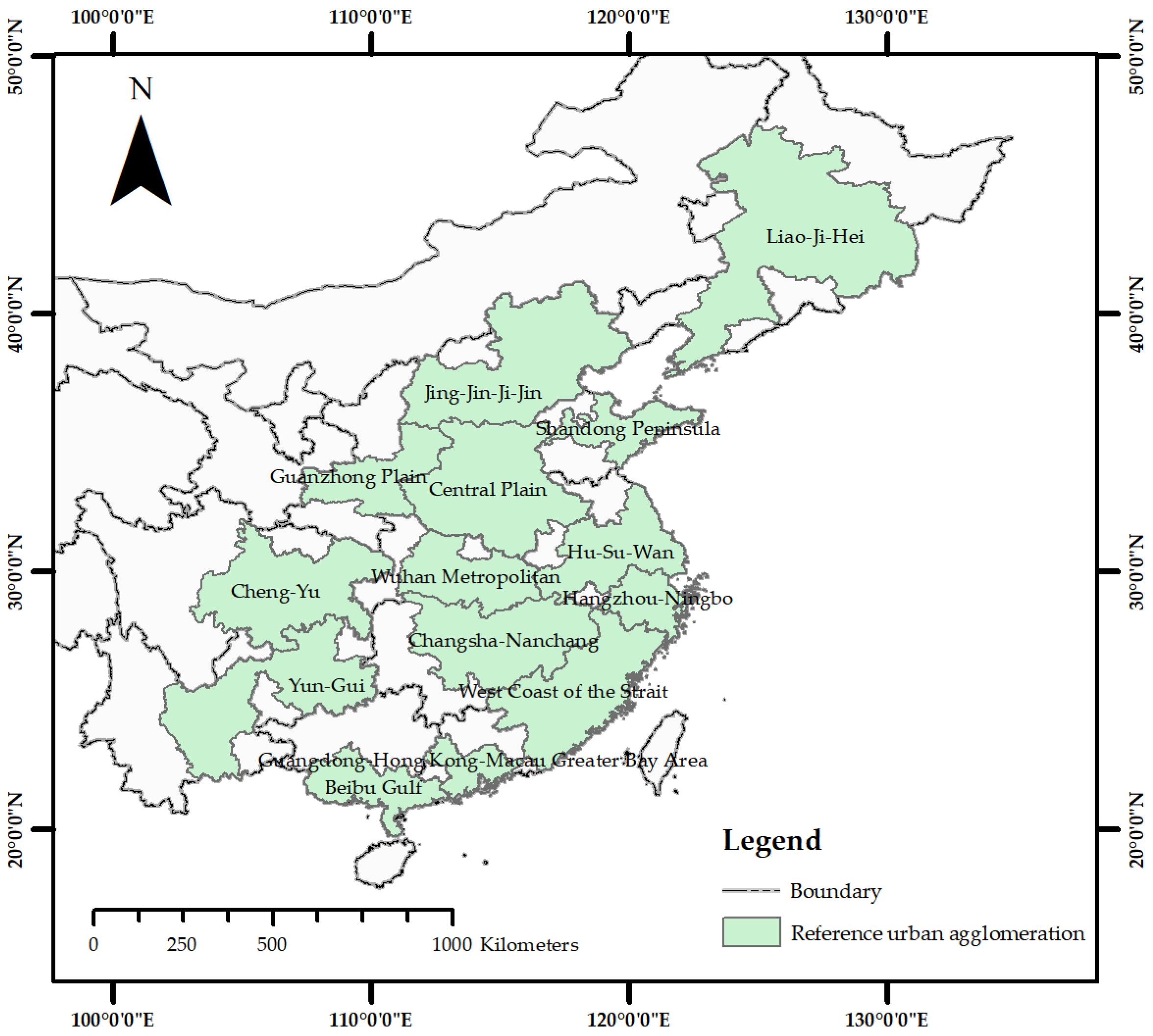

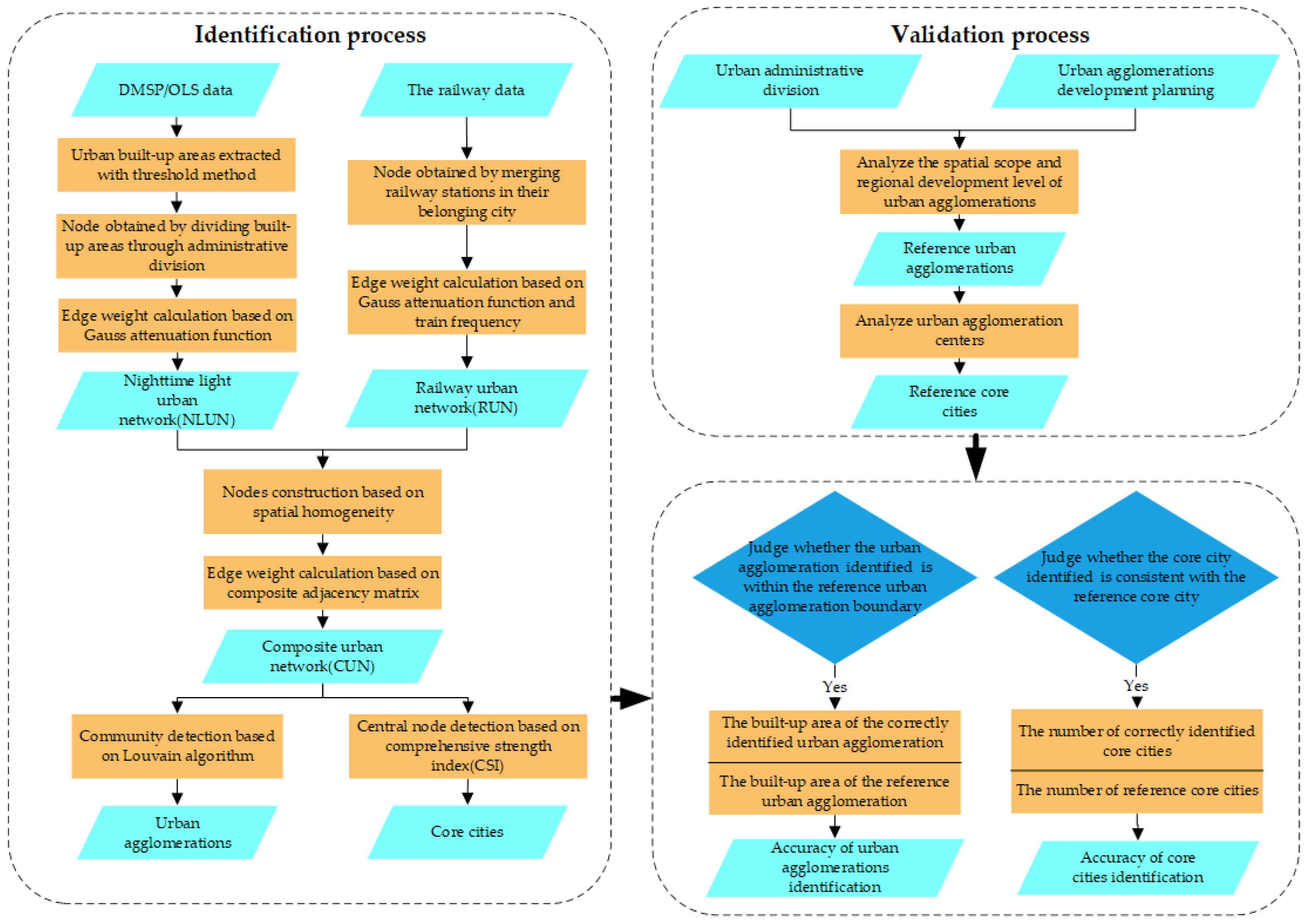
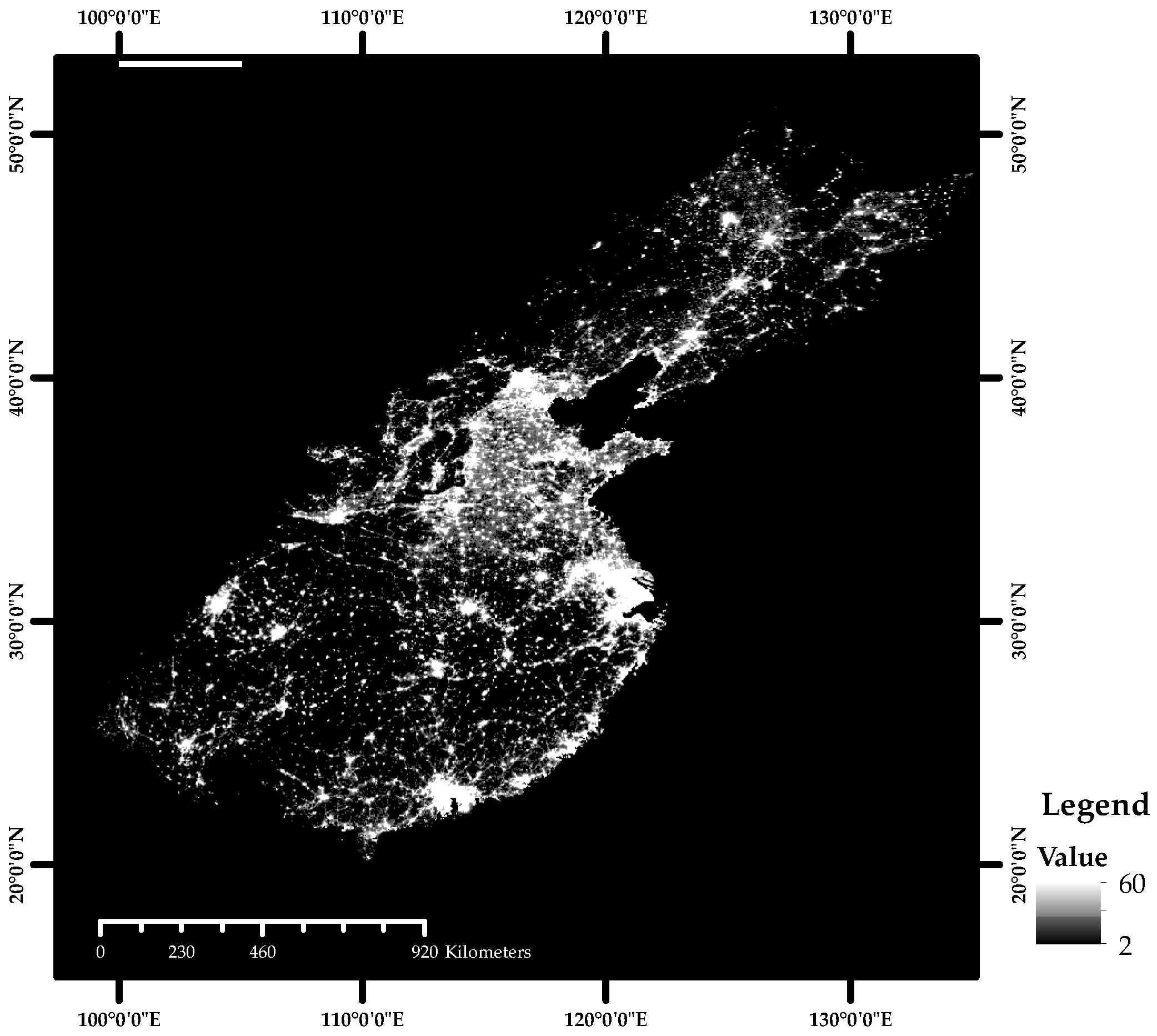
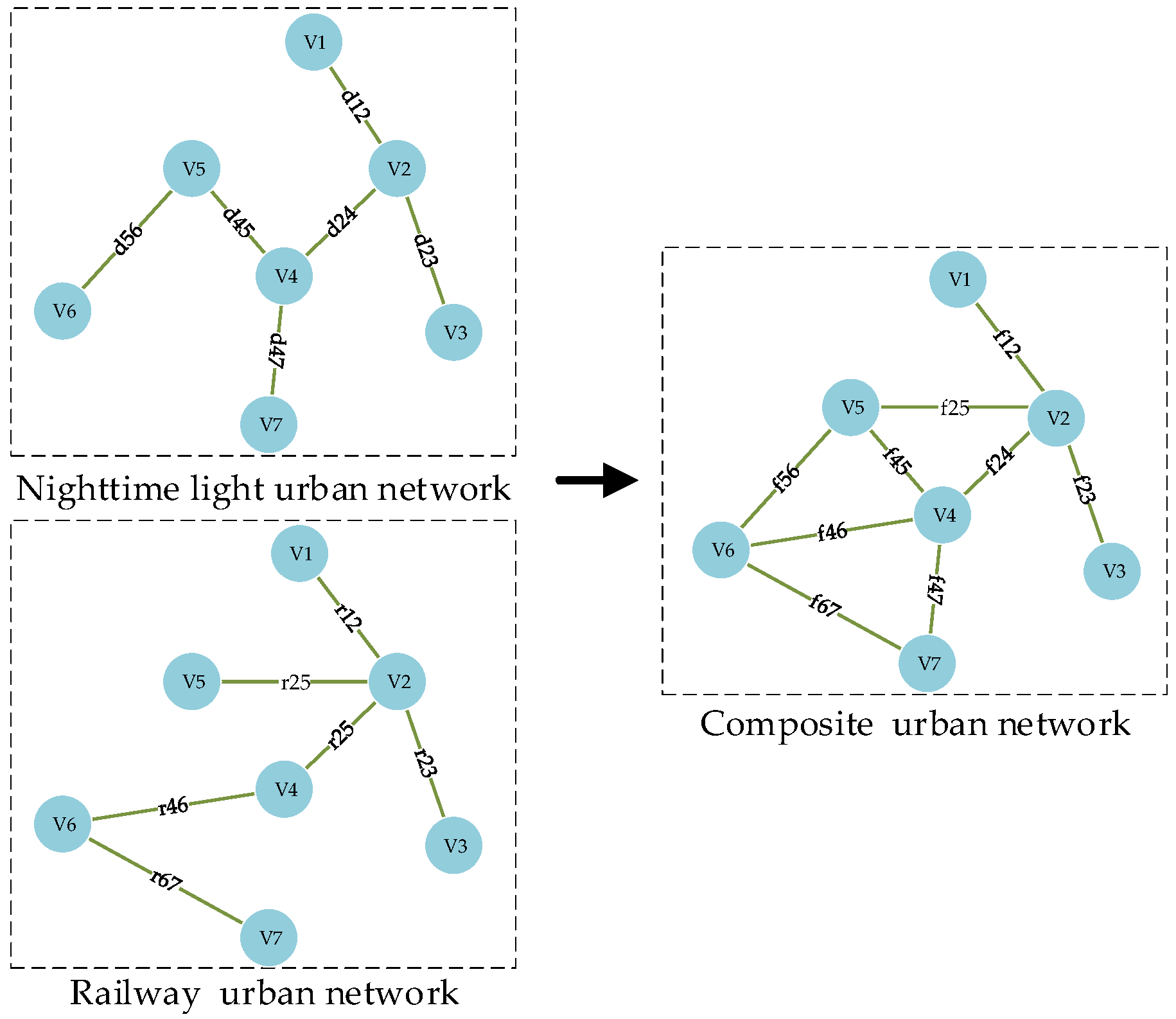

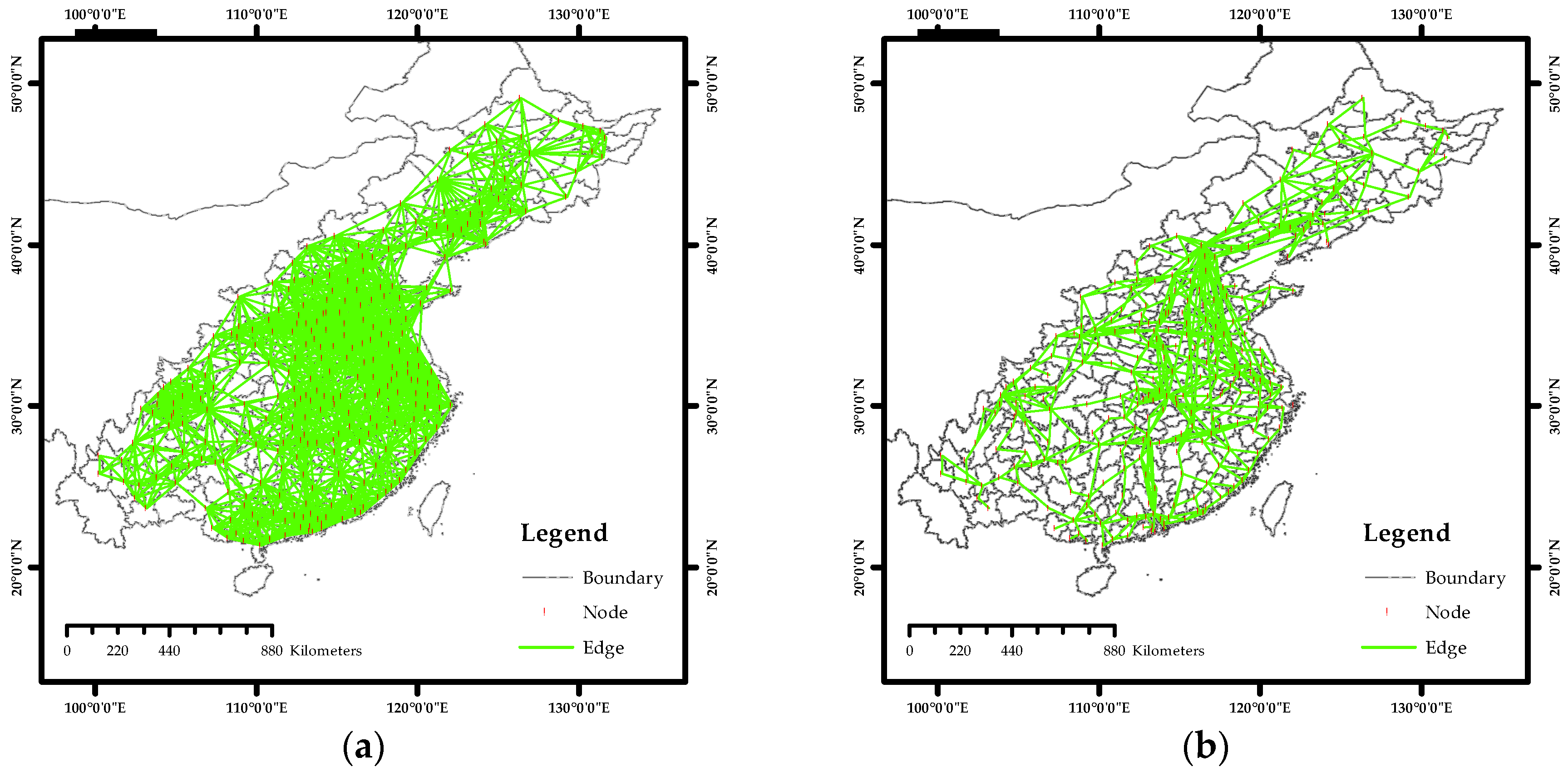

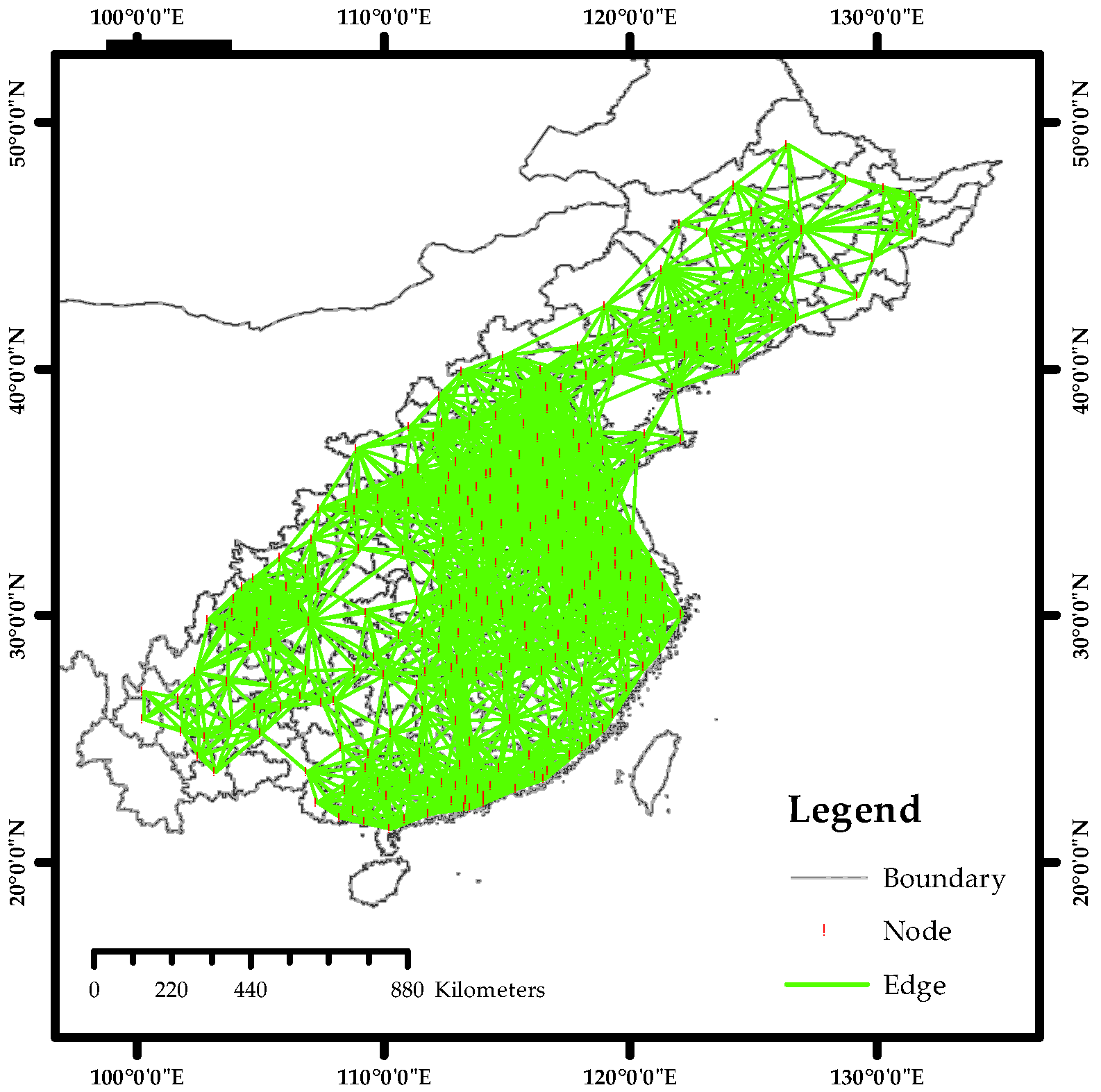
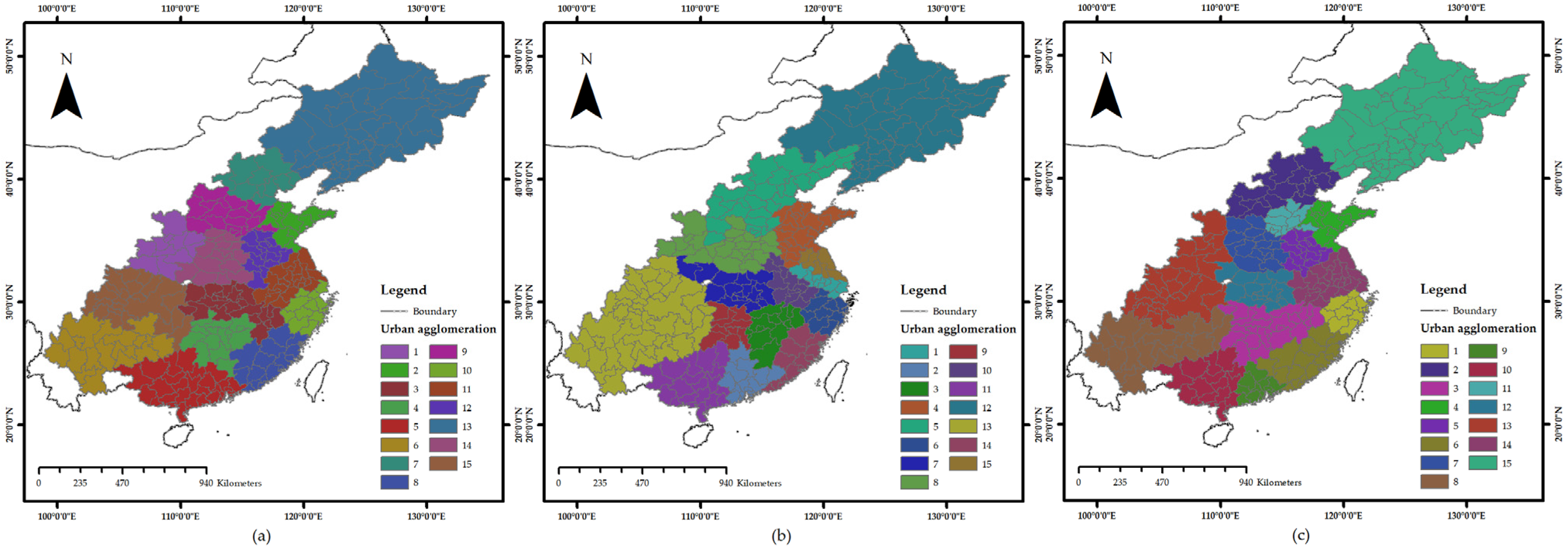
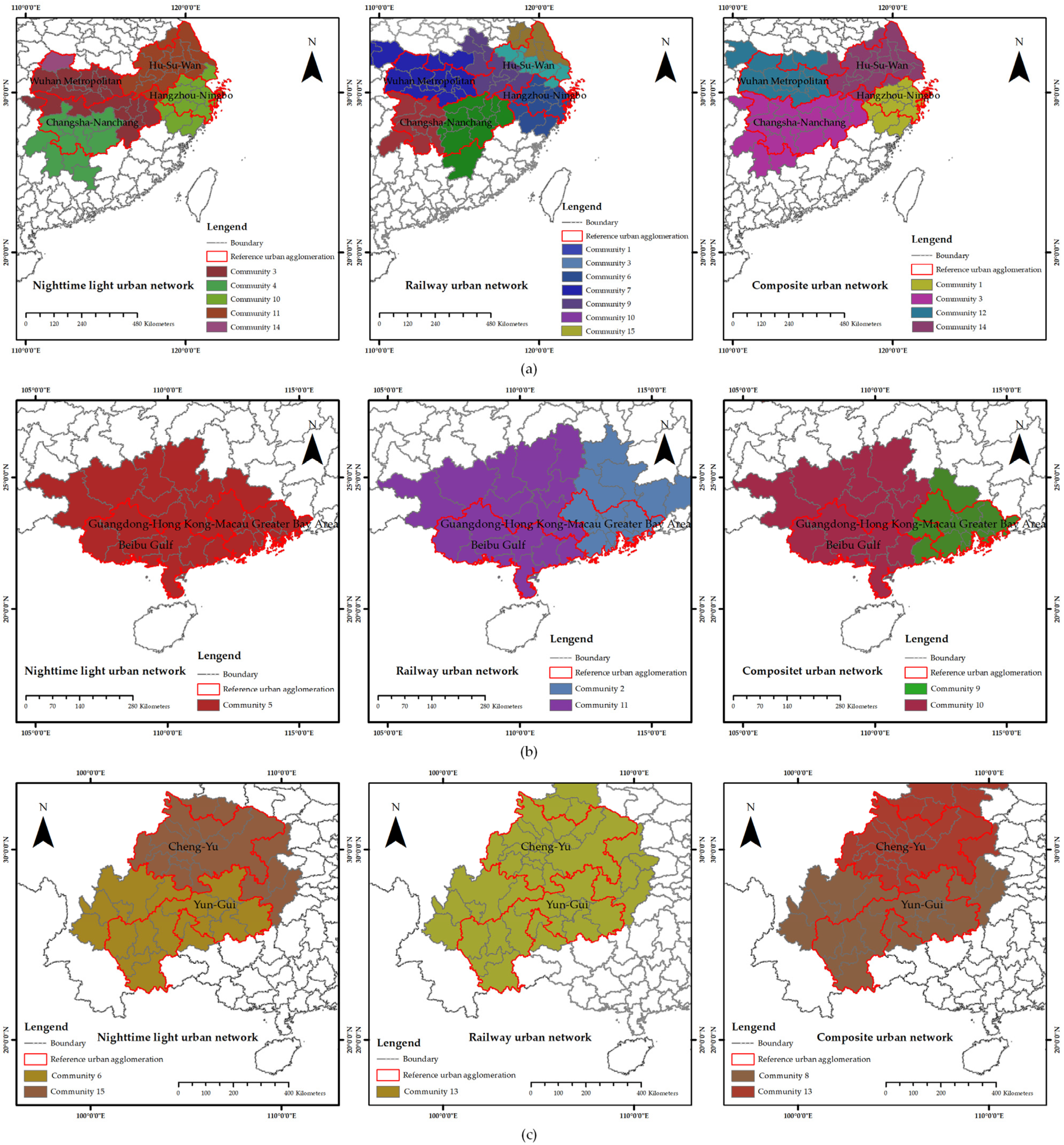
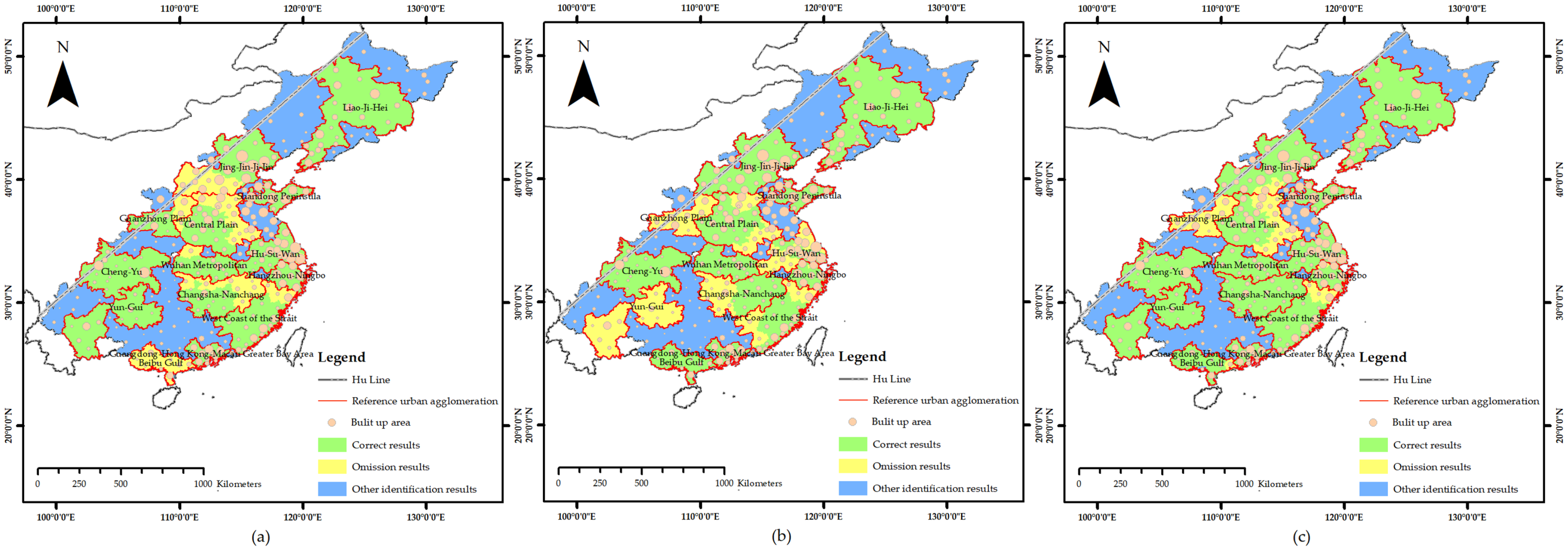
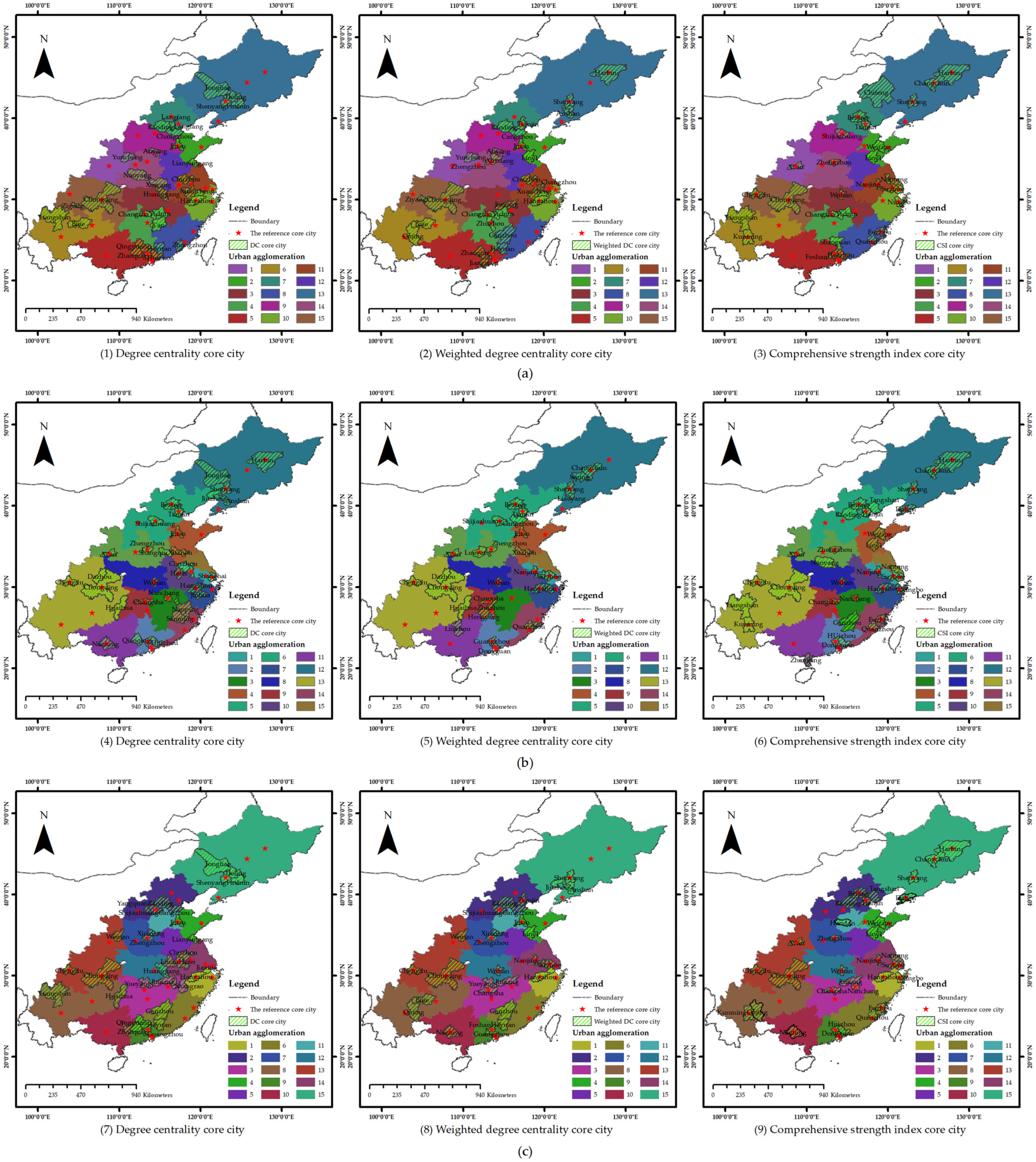
| Reference Urban Agglomerations | Core Cities |
|---|---|
| Hu-Su-Wan | Shanghai, Nanjing, Hefei, Suzhou |
| Hangzhou-Ningbo | Hangzhou, Ningbo |
| Guangdong-Hong Kong-Macau Greater Bay Area | Guangzhou, Shenzhen, Hong Kong |
| Jing-Jin-Ji-jin | Beijing, Tianjin, Shijiazhuang, Taiyuan |
| Central Plain | Zhengzhou, Luoyang |
| Cheng-Yu | Chengdu, Chongqing |
| Guanzhong Plain | Xi’an |
| West coast of the Strait | Fuzhou, Xiamen |
| Shandong Peninsula | Jinan, Qingdao |
| Changsha-Nanchang | Changsha, Zhuzhou, Nanchang |
| Wuhan Metropolitan | Wuhan |
| Liao-Ji-Hei | Shenyang, Dalian, Harbin |
| Beibu Gulf | Nanning |
| Yun-Gui | Kunming, Guiyang |
| Urban agglomeration | Core cities |
| Urban Agglomeration | NLUN | RUN | CUN |
|---|---|---|---|
| Hangzhou-Ningbo | Community 10 | Community 6 | Community 1 |
| Jing-Jin-Ji-Jin | Community 7, 9 | Community 5 | Community 2 |
| Changsha-Nanchang | Community 4 | Community 3, 9 | Community 3 |
| Shandong Peninsula | Community 1 | Community 4 | Community 4 |
| Central Anhui | Community 12 | Community 4 | Community 5 |
| West coast of the Strait | Community 8 | Community 14 | Community 6 |
| Central Plain | Community 14 | Community 8 | Community 7, 11 |
| Cheng-Yu | Community 15 | Community 13 | Community 8 |
| Guanzhong Plain | Community 2 | Community 8 | Community 8 |
| Guangdong-Hong Kong-Macau Greater Bay Area | Community 5 | Community 2 | Community 9 |
| Beibu Gulf | Community 5 | Community 11 | Community 10 |
| Wuhan Metropolitan | Community 3 | Community 7 | Community 12 |
| Yun-Gui | Community 6 | Community 13 | Community 13 |
| Hu-Su-Wan | Community 11 | Community 1, 10 15 | Community 14 |
| Liao-Ji-Hei | Community 13 | Community 12 | Community 15 |
| Urban Agglomeration | NLUN | RUN | CUN |
|---|---|---|---|
| Hangzhou-Ningbo | 24,369.24 | 20,226.29 | 21,447.46 |
| Jing-Jin-Ji-Jin | 44,170.37 | 38,797.20 | 60,470.81 |
| Changsha-Nanchang | 8132.13 | 7797.43 | 15,377.77 |
| Shandong Peninsula | 29,670.04 | 29,670.04 | 29,670.04 |
| Liao-Ji-Hei | 40,561.12 | 40,561.12 | 40,561.12 |
| West Coast of Strait | 22,433.45 | 20,271.52 | 22,433.45 |
| Central Plain | 25,110.99 | 29,697.18 | 26,974.41 |
| Yun-Gui | 11,252.91 | 0 | 11,252.91 |
| Guangdong-Hong Kong-Macau Greater Bay Area | 22,153.03 | 22,153.03 | 22,153.03 |
| Beibu Gulf | 0 | 9344.255 | 8258.77 |
| Wuhan Metropolitan | 10,872.99 | 12,157.48 | 12,157.48 |
| Cheng-Yu | 19,719.72 | 19,719.72 | 19,719.72 |
| Guanzhong Plain | 9823.28 | 0 | 0 |
| Hu-Su-Wan | 52,347.72 | 30,502.25 | 52,347.73 |
| Total: () | 320,617.00 | 280,897.52 | 342,824.70 |
| Accuracy | 82.52% | 72.30% | 88.24% |
| (1) Identification of Core Cities Using the Nighttime Light Urban Network. | |||
| Urban Agglomeration | Degree Centrality Core City | Weighted Degree Centrality Core City | Comprehensive Strength Index Core City |
| Hu-Su-Wan | Nanjing, Chuzhou, Wuhu, Xuancheng | Nanjing, Chuzhou, Wuhu, Changzhou | Nanjing, Suzhou, Taizhou, Nantong |
| Hangzhou-Ningbo | Hangzhou, Huzhou | Hangzhou, Huzhou | Ningbo, shanghai |
| Guangdong-Hong Kong-Macau Greater Bay Area, Beibu Gulf | Guangzhou, Huizhou, Zhaoaoqing, Qingyuan | Guangzhou, Foshan, Jiangmen, Zhaoaoqing | Guangzhou, Huizhou, Foshan, Dongguan |
| Jing-Jin-Ji-Jin | Langfang, Baoding, Cangzhou, Anyang | Tianjin, Baoding, Cangzhou, Anyang | Beijing, Tianjin, Shijiazhuang, Baoding |
| Central Plain | Nanyang, Xinyang | Zhengzhou, Xinxiang | Zhengzhou, Luoyang |
| Cheng-Yu | Chongqing, Zigong | Chongqing, Ziyang | Chongqing, Chengdu |
| Guanzhong Plain | Yuncheng | Yuncheng | Xi’an |
| West Coast of the Strait | Zhangzhou, Heyuan | Zhangzhou, Heyuan | Fuzhou, Quanzhou |
| Shandong Peninsula | Jinan, Lianyungang | Jinan, Linyi | Erifang, Linyi |
| Changsha-Nanchang | Changsha, Yichun, Ji’an | Changsha, Zhuzhou, Yichun | Changsha, Yichun, Shaoguan |
| Wuhan Metropolitan | Huanggang | Jiujiang | Wuhan |
| Liao-Ji-Hei | Shenyang, Tieling, Fushun, Tongliao | Shenyang, Harbin, Liaoyang, Anshan | Shenyang, Harbin, Changchun, Chifeng |
| Yun-Gui | Bijie, Liangshan Yi autonomous prefecture | Qujing, Bijie | Kunming, Liangshan Yi autonomous prefecture |
| (2) Identification of Core Cities Using the Railway Urban Network. | |||
| Urban Agglomeration | Degree Centrality Core City | Weighted Degree Centrality Core City | Comprehensive Strength Index Core City |
| Hu-Su-Wan | Nanjing, Hefei, Shanghai, Chuzhou | Nanjing, Suzhou, Wuxi, Changzhou | Nanjing, Suzhou, Shanghai, Nantong |
| Hangzhou-Ningbo | Hangzhou, Jinhua | Hangzhou, Shaoxing | Hangzhou, Ningbo |
| Guangdong-Hong Kong-Macau Greater Bay Area | Guangzhou, Huizhou, Zhaoaoqing | Guangzhou, Shenzhen, Dongguan | Guangzhou, Huizhou, Dongguan |
| Jing-Jin-Ji-Jin | Beijing, Tianjin, Shijiazhuang, Jinzhou | Beijing, Tianjin, Shijiazhuang, Cangzhou | Beijing, Tianjin, Baoding, Tangshan |
| Central Plain, Guanzhong Plain | Zhengzhou, Shangqiu, Xi’an | Zhengzhou, Luoyang, Xi’an | Zhengzhou, Nanyang, Xi’an |
| Cheng-Yu | Chongqing, Chengdu | Chongqing, Chengdu | Chongqing, Chengdu |
| West Coast of the Strait | Nanping, Shanming | Quanzhou, Putian | Fuzhou, Quanzhou |
| Shandong Peninsula | Jinan, Xuzhou | Jinan, Xuzhou | Weifang, Linyi |
| Changsha-Nanchang | Changsha, Nanchang, Yingtan | Changsha, Zhuzhou, Hengyang | Changsha, Nanchang, Ganzhou |
| Wuhan Metropolitan | Wuhan | Wuhan | Wuhan |
| Liao-Ji-Hei | Shenyang, Harbin, Tongliao, Anshan | Shenyang, Changchun, Liaoyang, Siping | Shenyang, Harbin, Changchun, Dalian |
| Beibu Gulf | Nanning | Liuzhou | Zhanjiang |
| Yun-Gui | Huaihua, Dazhou | Huaihua, Dazhou | Kunming, Qujing |
| (3) Identification of Core Cities Using the Composite Urban Network. | |||
| Urban Agglomeration | Degree Centrality Core City | Weighted Degree Centrality Core City | Comprehensive Strength Index Core City |
| Hu-Su-Wan | Hefei, Chuzhou, Wuhu, Liuan | Nanjing, Suzhou, Wuxi, Changzhou | Nanjing, Suzhou, Shanghai, Nantong |
| Hangzhou-Ningbo | Hangzhou, Jiaxing | Hangzhou, Jiaxing | Hangzhou, Ningbo |
| Guangdong-Hong Kong-Macau Greater Bay Area | Guangzhou, Qingyuan, Zhaoaoqing | Guangzhou, Foshan, Dongguan | Guangzhou, Huizhou, Dongguan |
| Jing-Jin-Ji-Jin | Shijiazhuang, Cangzhou, Baoding, Yangqquan | Tianjin, Shijiazhuang, Cangzhou, Baoding | Beijing, Tianjin, Baoding, Tangshan |
| Central Plain | Zhengzhou, Xinxiang | Zhengzhou, Xinxiang | Zhengzhou, Handan |
| Cheng-Yu, Guanzhong Plain | Chongqing, Chengdu, Weinan | Chongqing, Chengdu, Weinan | Chongqing, Chengdu, Xi’an |
| West Coast of the Strait | Ganzhou, Heyuan | Ganzhou, Heyuan | Fuzhou, Quanzhou |
| Shandong Peninsula | Jinan, Lianyungang | Jinan, Linyi | Weifang, Linyi |
| Changsha-Nanchang | Yueyang, Jiujiang, Shangrao | Changsha, Yueyang, Jiujiang | Changsha, Nanchang, Jiujiang |
| Wuhan Metropolitan | Huanggang | Wuhan | Wuhan |
| Liao-Ji-Hei | Shenyang, Tongliao, Anshan, Tieling | Shenyang, Anshan, Liaoyang, Jinzhou | Shenyang, Harbin, Changchun, Dalian |
| Beibu Gulf | Wuzhou | Nanning | Nanning |
| Yun-Gui | Huaihua, Liangshan Yi autonomous prefecture | Qujing, Bijie | Kunming, Qujing |
| Urban Network Model | Degree Centrality | Accuracy | Weighted Degree Centrality | Accuracy | Comprehensive Strength Index | Accuracy |
|---|---|---|---|---|---|---|
| NLUN | 7 | 21.21% | 11 | 33.33% | 19 | 57.58% |
| RUN | 19 | 57.58% | 19 | 57.58% | 21 | 63.63% |
| CUN | 9 | 27.27% | 14 | 42.42% | 22 | 66.67% |
Disclaimer/Publisher’s Note: The statements, opinions and data contained in all publications are solely those of the individual author(s) and contributor(s) and not of MDPI and/or the editor(s). MDPI and/or the editor(s) disclaim responsibility for any injury to people or property resulting from any ideas, methods, instructions or products referred to in the content. |
© 2022 by the authors. Licensee MDPI, Basel, Switzerland. This article is an open access article distributed under the terms and conditions of the Creative Commons Attribution (CC BY) license (https://creativecommons.org/licenses/by/4.0/).
Share and Cite
Xie, Z.; Yuan, M.; Zhang, F.; Chen, M.; Tian, M.; Sun, L.; Su, G.; Liu, R. A Structure Identification Method for Urban Agglomeration Based on Nighttime Light Data and Railway Data. Remote Sens. 2023, 15, 216. https://doi.org/10.3390/rs15010216
Xie Z, Yuan M, Zhang F, Chen M, Tian M, Sun L, Su G, Liu R. A Structure Identification Method for Urban Agglomeration Based on Nighttime Light Data and Railway Data. Remote Sensing. 2023; 15(1):216. https://doi.org/10.3390/rs15010216
Chicago/Turabian StyleXie, Zhiwei, Mingliang Yuan, Fengyuan Zhang, Min Chen, Meng Tian, Lishuang Sun, Guoqing Su, and Ruizhao Liu. 2023. "A Structure Identification Method for Urban Agglomeration Based on Nighttime Light Data and Railway Data" Remote Sensing 15, no. 1: 216. https://doi.org/10.3390/rs15010216
APA StyleXie, Z., Yuan, M., Zhang, F., Chen, M., Tian, M., Sun, L., Su, G., & Liu, R. (2023). A Structure Identification Method for Urban Agglomeration Based on Nighttime Light Data and Railway Data. Remote Sensing, 15(1), 216. https://doi.org/10.3390/rs15010216







